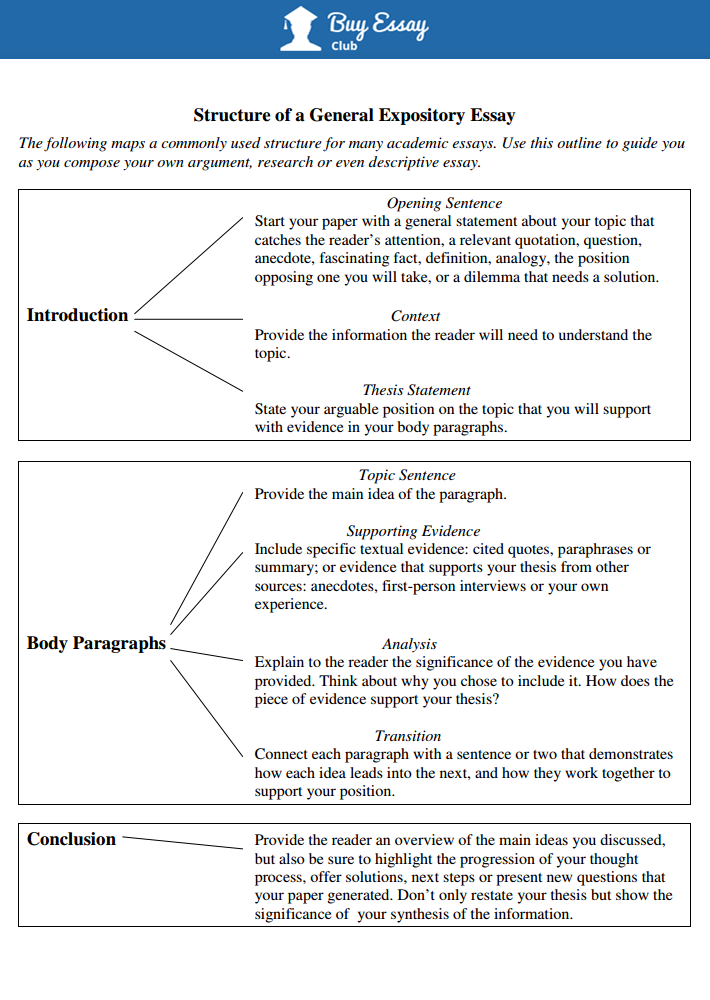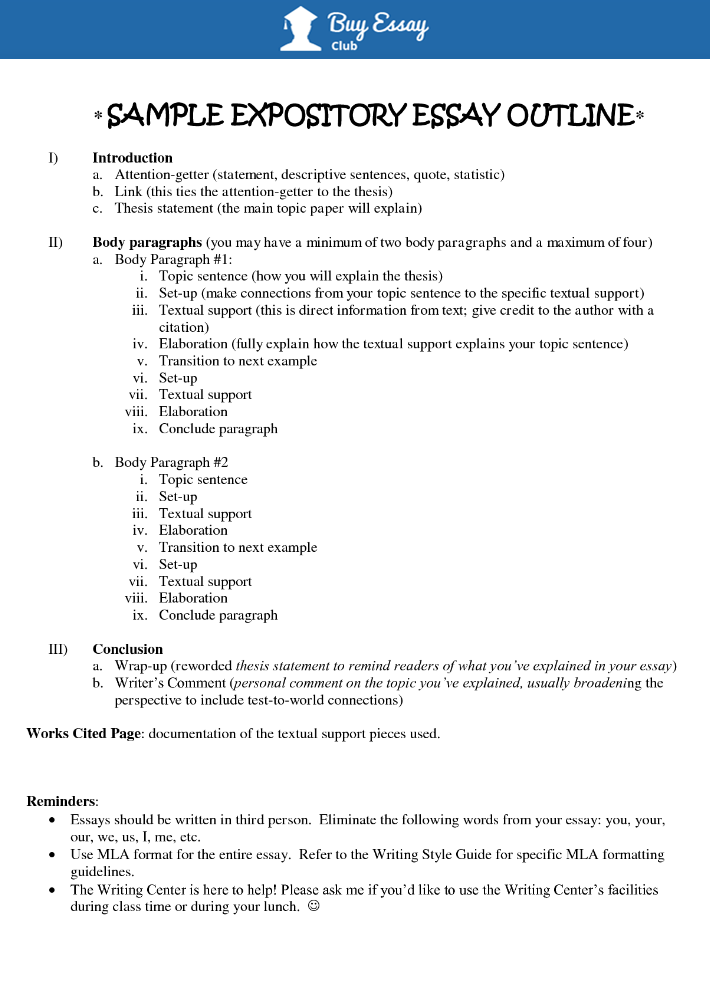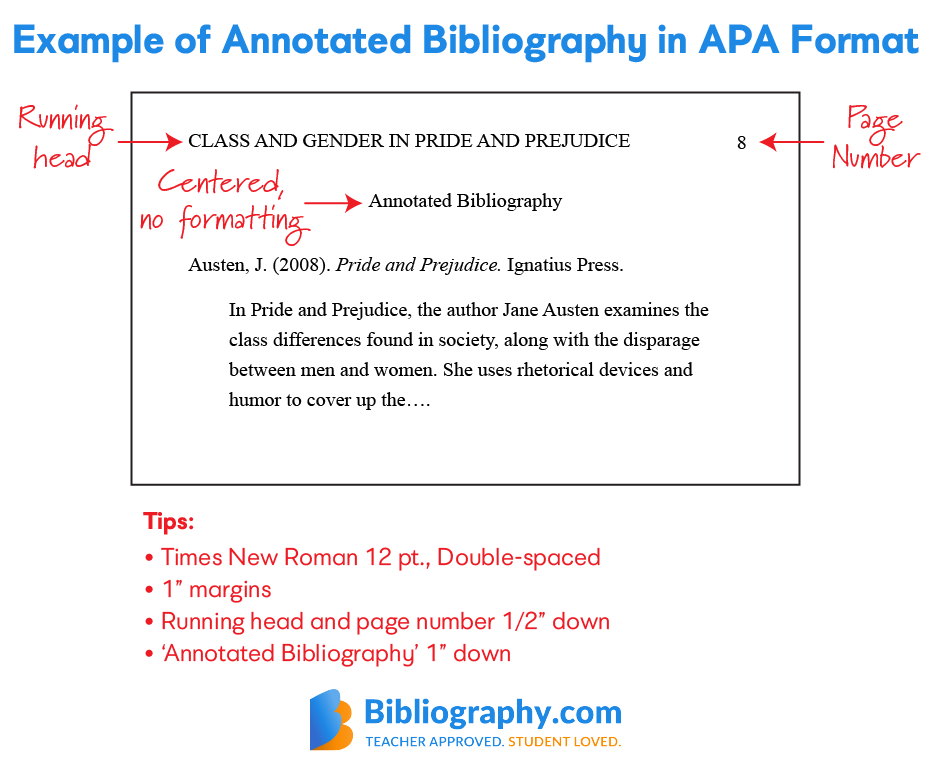
· Revised on October 15, “Expository” means “intended to explain or describe something.”. An expository essay provides a clear, focused explanation of a particular topic, process, or set of ideas. It doesn’t set out to prove a point, just to give a balanced view of its subject matter. Expository essays are usually short assignments intended to test your composition skills or your · As a rule, expository writing is done in MLA format and typically has a standard 5-paragraph essay structure: Paragraph 1: Introduction with a hook to grab your readers’ attention, and a thesis statement that clearly presents the main concept and goal of your paper. Paragraph 2: Body, 1st point/argument with supporting evidence This structure has three main parts that include: Introduction with a thesis or the topic to be explained or taught Body of writing where you lay out your arguments or ideas, or take the reader through the process step-by-step Conclusion – where you sum up the main ideas and arguments
6 Types Of Expository Writing with Examples
Expository writing is a widespread form of writing. Expository writing is writing that explains or teaches how to do something, convinces the reader of an argument, compares issues or clarifies something. Like its name, the goal of expository writing is to expose, clarify or explain something. It often has a consistent structure and uses clear, simple language, along with well-researched facts and arguments to convey its message.
In this article, you will learn the essential elements of expository writing, the different types, and how to craft a well-written essay. Expository writing is everywhere, and its goal is to help the reader understand something, teach a lesson step by step or argue for a point of view.
It is helpful to imagine that your reader knows nothing about your issue or topic, and you need to explain it to them clearly and simply. Expository writing is very different from narrative and descriptive writing. With narrative writing, you are telling a story using expressive language and imagery. Descriptive writing also tries to paint a picture with words and convey an image or experience so the reader can understand. Expository writing should be clear and to the point. You do not need to tell a story or describe an event for your reader.
You do need to communicate an idea as clearly as possible. It should be easy to read with simple language and precise arguments and information. There are five main types of expository writing out there, explain expository writing.
These are:. Cause and Effect — This type of writing could be someone explaining why a particular event occurred and the impact that it will have. An example of this would be an article describing the causes of the recent bush fires in Australia and then explaining the effect that they will have on the future of the environment, explain expository writing.
The critical elements of this kind of writing are explaining why something explain expository writing and then the impact, or as the name says — cause and effect. How To — This kind of writing is reasonably self-explanatory. It is writing that explains step-by-step how to do something and guides the reader through a clear process.
It will clearly state the main problem or what it is teaching, the steps needed to complete the task or solve the problem and the intended result of the process. You need to clearly state what you are going to teach and then lay out the steps to complete the process. Compare and Contrast — This kind of writing compares two subjects and talks about their similarities and discusses their differences.
An example of this is an article comparing a visit to Disneyland and Disney World, explain expository writing. The writer could talk about the similarities of the two theme parks and explain expository writing their explain expository writing and which is preferred.
Problem and Solution — This kind of expository writing outlines an issue, describes it in detail and then suggests a solution or discusses possible solutions to the topic. This type of writing has a strong point of view and must back up all its statements and suggestions. An example of problem and solution expository writing is an article discussing single-use plastics and possible solutions to reduce waste.
It is essential for the writer to explain the problem clearly and what is involved and then clearly lay out possible solutions. Definitions and Classification — this kind of writing describes the characteristics of a topic and discusses the many different types of that topic.
An example of this kind of writing is this article you are reading right now. With expository writing, you are trying to explain something as concisely and simply as possible to your reader.
Often using simple words and clear arguments will make your point much more effectively than colourful, explain expository writing language. Expository writing also has a clear structure to help you layout your argument or convey your information to your reader.
This structure has three main parts that include:. If you want to write an expository piece, it helps to take things step-by-step. Here explain expository writing the steps to help you create a well-written piece of expository writing.
Clearly state your topic with a sentence or two that describes what you will be talking about in your writing. The introduction paragraph is also the place to include your thesis statement if you have one, that states clearly the argument or idea you are defending in your writing.
You should also briefly mention the arguments you will use later in your introductory paragraph. The body of your expository explain expository writing should clearly explain your arguments and back up the argument with clear facts and information. It also helps to give examples and specific details. Do some research so you have informed opinions and concrete facts for each of your arguments.
The conclusion is the part of your writing where you restate your issue or problem and your arguments into a concise conclusion.
If you are arguing for a particular point of view, this is where you clearly state your opinion and your reasons. It should be clear, concise and wrap up your explain expository writing. Ask them to read your manuscript and give feedback.
They should be able to understand how to do the task you have described, or be informed about the topic and your suggested solution after they read your piece, explain expository writing. If you are looking for help with expository writing or help writing an essaycontact us at Masters Essays, explain expository writing. Our highly qualified and professional writers would be happy to help you manage your workload and make sure your writing is on track to meet your academic goals.
Skip to content. Expository Writing: How to Write to Explain. Explain expository writing this on
How to Teach Transition Words in Writing - Instructional Video - Flipped Classrooms or In Class
, time: 5:38Expository Writing

· Revised on October 15, “Expository” means “intended to explain or describe something.”. An expository essay provides a clear, focused explanation of a particular topic, process, or set of ideas. It doesn’t set out to prove a point, just to give a balanced view of its subject matter. Expository essays are usually short assignments intended to test your composition skills or your What is Expository Writing? Exposition is a type of oral or written discourse that is used to explain, describe, give information or inform. The creator of an expository text can not assume that the reader or listener has prior knowledge or prior understanding of the topic that is being discussed · As a rule, expository writing is done in MLA format and typically has a standard 5-paragraph essay structure: Paragraph 1: Introduction with a hook to grab your readers’ attention, and a thesis statement that clearly presents the main concept and goal of your paper. Paragraph 2: Body, 1st point/argument with supporting evidence

No comments:
Post a Comment